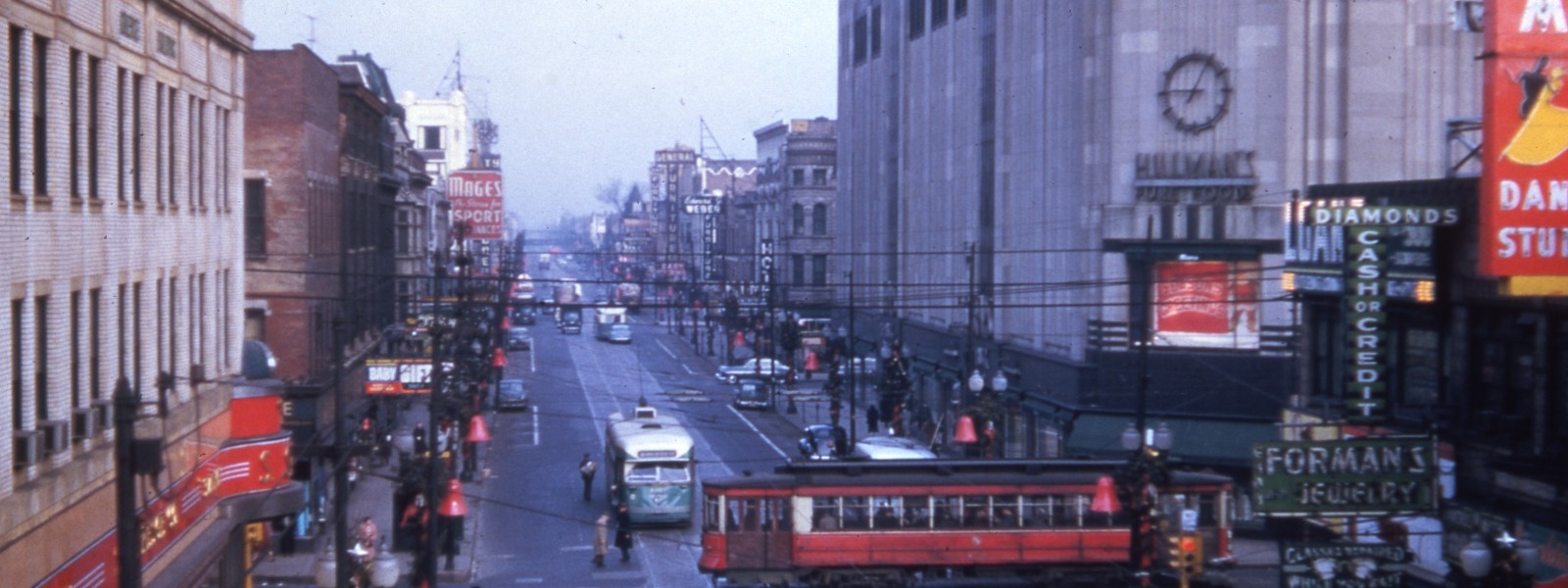From 1920-1950, 63rd Street was one of Chicago's largest commercial districts outside of the Loop...but today, many of its blocks seem quiet, even abandoned. How did this streetscape change so dramatically, in so short a period of time? These are the kinds of questions the Chicago Centuries Project (most recently, A Century on 63rd St.) aims to answer.
Above: 63rd and Halsted, 1952. (Photo from TrolleyDodger.com; original image by Stephen Scalzo, 1952 - see Illinois Railway Museum for more information.)
A Century on 63rd Street (1920-2020), AKA "Co63" was the second "chapter" of an ongoing undergraduate research project sponsored by Chicago Studies called the "Chicago Centuries Project." The research, which began on 55th Street/Garfield Boulevard, is building an open-access GIS map resource and associated digital archive documenting changes to the built environment, historic businesses, and land uses. As in Co55, students in the College (of any class and field of study) were able to contribute to this project as stipended research assistants, developing not only block-by-block microhistories but also longer-form narratives focused on their assigned blocks of 63rd St. Chicago Studies collaborated with Expositions Magazine to publish some of these stories in their Fall 2024 issue, devoted to histories of 63rd St.
63rd Street's narratives are less analyzed than those of Hyde Park (which has been the focus of some professional historical writing and was explored in Co55), but ample photographic and newspaper evidence exists about the street. Much of this has to do with its long history as an entertainment hub, especially in the Woodlawn neighborhood (east of King Boulevard, formerly South Park Way). This history, like much of the history of Chicago's mid-South Side, follows on Woodlawn's proximity to the 1893 World's Fair, which spurred a building boom along 63rd Street in the 1890's, including the development of the 63rd Street elevated train between Jackson Park and downtown and the expansion of the Cottage Grove trolley line, which ran between downtown and Commercial Ave. in Chicago's southeast steel district. In the decades following the Fair, Woodlawn's stretch of 63rd St. remained a vibrant entertainment district, home to the "White City" amusement park and numerous storied jazz clubs (some of which boasted drag performers as headliners in the 1930s-1950s). West of King/South Park, Englewood's easy rail access to the entire South Side (and also downtown) led to the formation of a tony commercial district, memorably headlined by a massive Sears, Roebuck & Co. flagship store at 63rd and Halsted. In the 1940s and '50s, this area rivaled the Loop in economic activity.
But as the South Side changed racially, first Woodlawn and then Englewood became hotspots of predatory and racist real estate exploitation. "Blockbusters" terrified White homeowners with tales of a forthcoming "Negro invasion" of the neighborhood, buying their homes at fire sale prices only to re-sell them at inflated rates to Black families desperate for entry into Chicago's fiercely segregated housing market. When these same families couldn't keep up with their loans' exorbitant rates of interest, the brokers would re-claim the homes and sell them again, perpetuating a cycle of block-by-block deterioration as building maintenance was ignored by cash-strapped, short-term owners. An unstable residential population could not sustain ongoing commercial development without outside assistance, but the focus of the City under Mayor Richard J. Daley and his successors was on the Central Business Area, and so 63rd Street's businesses slowly collapsed. Although groups like The Woodlawn Organization (TWO, founded as an organizing effort to resist UChicago's planned expansion south of the Midway in the 1960s) creatively promoted local enterprise and sustained the area's social services network, both neighborhoods continued to decline, losing almost 80% of their population between 1960 and 2020.
In recent years, Woodlawn (in particular) has been eyed as ripe for redevelopment, with a series of "master plans" drawn up on its behalf - most recently by the leadership of Apostolic Church of God (heirs to the mantel of TWO spokesman Bishop Arthur Brazier), a principal landowner along 63rd Street. Apostolic worked with the University of Chicago to secure Woodlawn as the site of the new Obama Presidential Library, whose campus borders Apostolic's own holdings at 63rd and Stony Island. But fears of gentrification and distrust of both institutions persist among local residents, who continue to fight potential displacement. Englewood is home to its own activism, some of it focused on the restoration of transit access to 63rd Street. Both neighborhoods continue to struggle with their images as "abandoned" communities, a narrative that persists (in part) because their histories have been so poorly preserved. Chicago Studies hopes to remedy that trend through its continued investigations into these fascinating communities along 63rd Street.
Chicago Centuries' work on 63rd Street is still in process; block-level data are still being refined and edited for accuracy, completeness, and formatting so that they can be integrated into a series of GIS map layers of the street prepared by Parker Otto and his team of student GIS mappers. For a taste of their work, explore the story map embedded below (visit the original here). This map series demonstrates the changes to the built environment along 63rd from approximately 1925-present. Another version of Parker's footprints can be found as the "table of contents" for Fall 2024's issue of Expositions Magazine, with some additional contextual elements from the magazine's cartographer Noam Levinsky.
